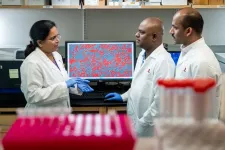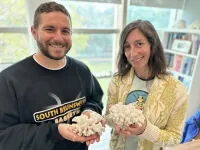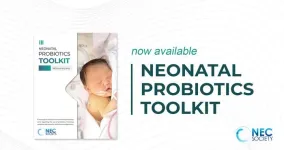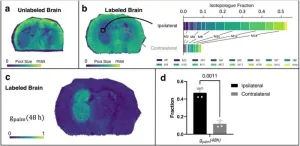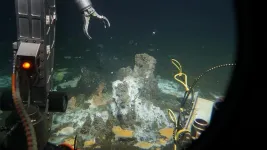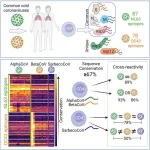Researchers develop new detection tool for beech leaf disease’s nematode pest
Researchers at the Holden Arboretum developed an improved, effective way to monitor and detect the presence of a disease-causing nematode in beech leaf tissue.
2023-06-02
(Press-News.org) Beech leaf disease is an emerging threat to North American forest ecosystems. It was first discovered in northeastern Ohio in 2012, and has already spread to 12 additional U.S. states and Canadian provinces. At first the cause of the disease was unknown, and the sick and dying trees were diagnosed on symptoms alone: Dark banding along the leaf veins and shriveled, leathery leaves. But in 2017, nematodes were found in diseased leaves, and by 2020 we had the answer: A newly recognized subspecies of the wormlike creature, Litylenchus crenatae mccannii, was definitely associated with the symptoms.
In order to monitor the spread of the disease, to understand the nemotode’s presence among both symptomatic and possibly asymptomatic trees, and to begin to develop control measures, forestry professionals will need a rapid, accurate method for detecting the nematodes. Before now, forest health professionals hoping to diagnose a tree would have to undertake a slow process that involves soaking leaves for twelve hours, further preparing samples and then looking for nematodes under a microscope. It’s a fine method for one expert to study one tree, but not one that can be readily used on a large scale.
In a new report, published by forest health researchers at the Holden Arboretum, the Ontario Forest Research Institute, and the U.S. Forest Service, the team outlines a new tool for detecting these nematodes. Their work appeared in the journal Plant Disease.
The new nematode detection tool utilizes a long-standing laboratory method that can be used to detect DNA specific to a certain organism. In this method, researchers use a short DNA sequence that is specific to the species of interest, called a primer, to identify and then amplify on-target DNA in a sample. The amplification step is a relatively basic laboratory technique, PCR, but the real challenge lies in developing the primer in the first place — which is exactly what the researchers have done.
“The new primer will make detection of the North American beech leaf nematode faster and easier, allowing forest health professionals across the U.S. and Canada to keep better tabs on this emerging disease,” says David Burke, Vice President for Science and Conservation at Holden Forests & Gardens, who led the work. “Better detection will mean more accurate monitoring and improved research on treatment.”
The new primer can be used to differentiate L. crenatae from other nematodes that might be found in areas affected by BLD, and also allows researchers to estimate the relative degree of nematode infestation between samples.
“We need all the forest professionals we can get working on BLD if we want to nip it in the bud,” says Burke. “Our forests may depend on it.”
—
Citation: Burke, David, et al. "Development of primers specific for detection of Litylenchus crenatae, the causal agent of beech leaf disease, in plant tissue." Plant Disease (2023). DOI: 10.1094/PDIS-12-22-2911-SR
About Holden Forests & Gardens: Holden Forests & Gardens is made up of two of Northeast Ohio’s most important environmental and cultural institutions — the Holden Arboretum and Cleveland Botanical Garden — whose mission is to connect people with the wonder, beauty, and value of trees and plants, to inspire action for healthy communities. One of the largest public gardens in the country, Holden Forests & Gardens has 18,000 member households and an annual attendance of nearly 350,000 for whom we strive to provide inspirational and educational visitor experiences. For more information, visit holdenfg.org.
Media Contact:
Anna Funk
Science Communications Specialist
Holden Forests & Gardens
afunk@holdenfg.org
Corresponding Author:
David Burke
Vice President for Science and Conservation
Holden Forests & Gardens
dburke@holdenfg.org
440-602-3858
END
[Attachments] See images for this press release:
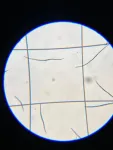
ELSE PRESS RELEASES FROM THIS DATE:
2023-06-01
(MEMPHIS, Tenn. – June 01, 2023) Infections and other diseases can cause red blood cells to rupture, releasing the oxygen-binding molecule hemoglobin, which breaks down into heme. Free heme can cause significant inflammation and organ damage, leading to morbidity and mortality. Researchers from St. Jude Children’s Research Hospital discovered NLRP12, an innate immune pattern recognition receptor, to be the key molecule responsible for inducing inflammatory cell death and pathology in response to heme combined with other cellular damage or infection. The finding provides a new potential drug target to prevent morbidity in certain illnesses. ...
2023-06-01
HOUSTON – (June 1, 2023) – An international team of marine biologists has discovered the remnants of ancient RNA viruses embedded in the DNA of symbiotic organisms living inside reef-building corals.
The RNA fragments are from viruses that infected the symbionts as long ago as 160 million years. The discovery is described in an open-access study published this week in the Nature journal Communications Biology, and it could help scientists understand how corals and their partners fight off viral infections today. But it was a surprising find because most RNA viruses are not known ...
2023-06-01
Davis, CA - The Necrotizing Enterocolitis (NEC) Society is thrilled to release the Neonatal Probiotics Toolkit. The Toolkit provides structure to clinicians in neonatal intensive care units (NICUs) as they consider the complex process and decision of whether to implement probiotics to help prevent NEC. The Toolkit is not a recommendation for or against the routine use of probiotics in the NICU, nor for or against the use of any product or preparation method.
NICUs and clinicians are encouraged to use the Toolkit to foster thoughtful, intentional dialogue and inclusive conversations amongst key stakeholders in the NICU, including the need for patient-families to understand ...
2023-06-01
Tumors are composed of rapidly multiplying cancer cells. Understanding which biochemical processes fuel their relentless growth can provide hints at therapeutic targets.
Researchers from Washington University in St. Louis have developed a technology to study tumor growth in another dimension — literally. The scientists established a new method to watch what nutrients are used at which rates spatially throughout a tissue.
By using this multidimensional imaging approach, they identified pathways whose activities are uniquely elevated in brain cancer, offering clues for potential treatment strategies. The study was published May 19 in Nature Communications.
“We ...
2023-06-01
COLUMBUS, Ohio – The results of a new clinical trial suggest that the first drug therapy to slow the progression of nearsightedness in kids could be on the horizon.
The three-year study found that a daily drop in each eye of a low dose of atropine, a drug used to dilate pupils, was better than a placebo at limiting eyeglass prescription changes and inhibiting elongation of the eye in nearsighted children aged 6 to 10.
That elongation leads to myopia, or nearsightedness, which starts in young kids and ...
2023-06-01
New Haven, Conn. — Yale University’s museums, libraries, and archives contain vast troves of cultural and scientific heritage that fire curiosity and fuel research worldwide. Now there’s a simple new way to make astonishing connections among millions of objects.
Starting today, anyone can explore the university’s unparalleled holdings online through LUX: Yale Collections Discovery — a groundbreaking discovery and research platform that provides single-point access to more than 17 million items, including defining specimens ...
2023-06-01
Microbial communities are especially active near hydrothermal seeps like those in the Guaymas Basin in the Gulf of California. The team of researchers has been working on understanding these communities for many years. Organic material deposited in the Guaymas Basin is cooked by heat sources from within the Earth, which breaks it down into crude oil and natural gas. Their components provide the primary source of energy for microorganisms in an otherwise hostile environment. In their latest study, the researchers have demonstrated that archaea use a previously unknown mechanism to degrade liquid petroleum ...
2023-06-01
– Cutting-edge spatial omics technologies to map cancer cells and their immune environment in high resolution, allowing AI to unlock potential for new breakthrough treatments –
– Landmark research project is 100x larger than existing efforts –
– Data will be generated from thousands of patients across multiple cancers –
– University of Pittsburgh, Gustave Roussy, Lausanne University Hospital, Uniklinikum Erlangen/Friedrich-Alexander-Universität Erlangen-Nürnberg , Charité ...
2023-06-01
CHAPEL HILL, N.C. – On July 1, North Carolina’s new abortion limits go into effect. As restrictions on abortions are being tightened across the United States, adolescents may encounter mounting obstacles that could prevent them from accessing abortion care.
Bianca A. Allison, MD MPH, an assistant professor in the Department of Pediatrics, sought to examine the awareness and knowledge that adolescents have about the legal landscape of abortion and how these changes might affect them and their communities.
The study, published in the Journal of Adolescent Health, found that many adolescents – across a diversity of ...
2023-06-01
LA JOLLA, CA—Scientists at La Jolla Institute for Immunology (LJI) are investigating how the immune system's T cells react to a wide variety of coronaviruses, ranging from SARS to common cold coronaviruses. Their goal is to guide the development of vaccines that could halt future pandemic by combatting many types of coronaviruses at once.
"While it was recognized that coronaviruses were potentially dangerous viruses, because of SARSCoV and MERS viruses causing very severe disease in humans, nobody knew that the next pandemic was going to be caused by SARS-CoV-2," says LJI Professor Alessandro Sette, Dr.Biol.Sci. ...
LAST 30 PRESS RELEASES:
[Press-News.org] Researchers develop new detection tool for beech leaf disease’s nematode pest
Researchers at the Holden Arboretum developed an improved, effective way to monitor and detect the presence of a disease-causing nematode in beech leaf tissue.

